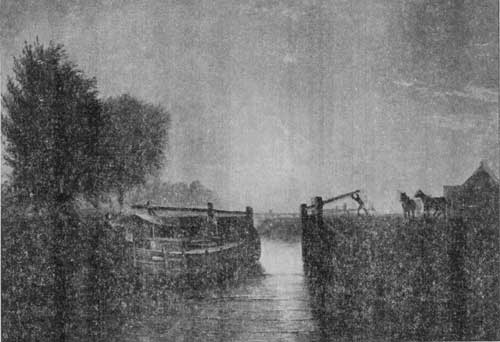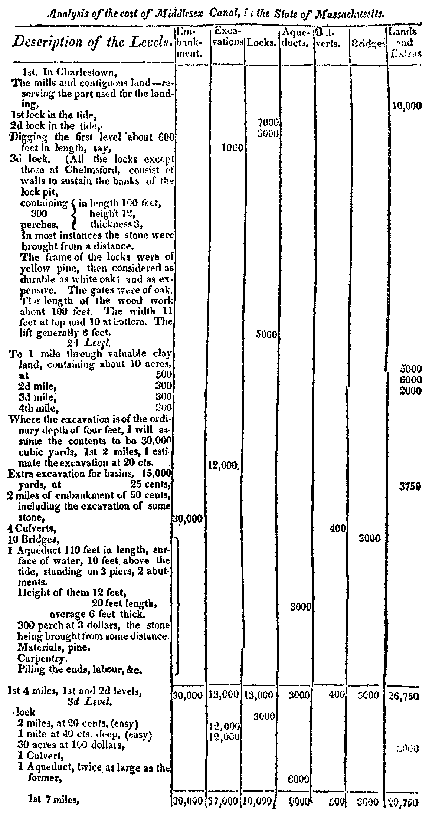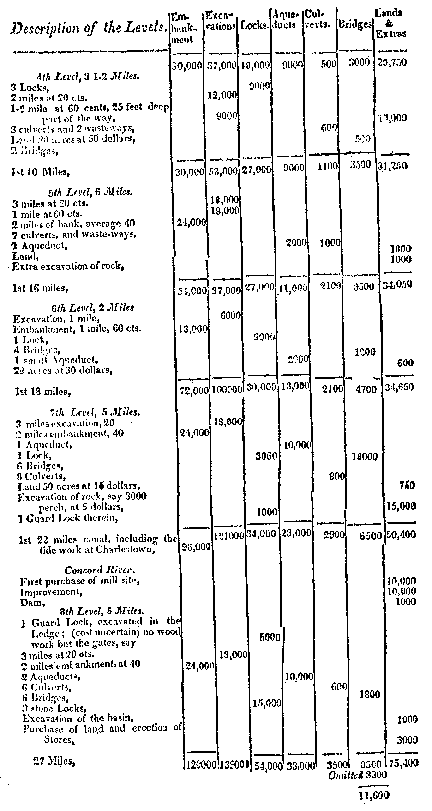

Published by the Middlesex Canal Association
Billerica, Massachusetts
Vol. 3, No. 2 September, 1965
ANNUAL MEETING
The annual meeting of the Association will take place at 2:00 p.m. on Saturday, October 2, 1965, in the hall of the Unitarian Church in Billerica Centre. Following a short business meeting, there will be a talk, by a speaker to be announced, on the current proposal to use the Middlesex Canal to divert water from the Concord River to the Ipswich River. Since this undertaking might ensure the preservation of the Canal, the talk should be most interesting.
The Museum (with many new exhibits) will be open from 1:00 to 2:00 p.m. and after the meeting. It is located in the rear of the Billerica Historical Society house, at 36 Concord Road, a very short walk from the Unitarian Church.
CANAL PAINTING
Reproduced below is a Canal Scene, possibly of the Middlesex Canal, by E. T. Baker (circa 1850-1875). The original is 18 x 25 inches and is for sale by the Vose Galleries of 238 Newbury Street, Boston. Interested persons are invited to see the painting at the Vose Galleries, whose kind permission to reproduce it here is gratefully acknowledged.

A.M.C. WALK - SEPTEMBER 25
Another traditional fall activity will take place on September 25, 1965, at 1:00 p.m. Members interested in joining the Canal walk co-sponsored by the Appalachian Mountain Club should meet on the Billerica Centre Common. There will be a ride to North Billerica and a walk by the Canal to the Richardson School on Route 129, where the Scout mothers of Troop 55 will serve the usual delicious buffet supper at a charge of 95¢. Reservations for the supper should be made ahead through Fred Lawson, Jr., MOntrose 3-6969.
AMENDMENT OF BY-LAWS
Notice is hereby given of a proposed amendment to the by-laws, relating to the number of directors, by striking out Article IV, Section 3, and substituting the following:
"The Proprietors shall elect a board of thirteen directors: included in this number shall be a president, vice president, treasurer, recording secretary, corresponding secretary, curator and six other directors."
This change is proposed to make the number of directors of the Association conform to the number of directors of the original Proprietors of the Middlesex Canal.
RECENT ACCESSIONS
Letter from J. L. Sullivan to New York Canal Commissioners
advising concerning the cost of proposed Erie Canal.
Extracts from a letter to the President of the New York Board of Commissioners from John L. Sullivan, Esquire, Superintendent of the Middlesex Canal.
Albany, March 7, 1817
The Hon. DeWitt Clinton
President of the Board of Canal Commissioners
Sir:
The Middlesex canal is 27 miles in length: its depth is intended to carry at least 3 feet of water. The banks, where formed, are meant to be one foot above the water. The width generally 30 feet on the surface, and on the bottom 20 feet. In carrying the work on, it was found necessary to purchase some estates, the whole of which was not essential to the canal. The lands were generally paid for, where most valuable. There was some considerable expense attending litigations, and perhaps some mistakes, which are not likely to happen in the proposed work. The whole expense in assessments has been 520,000 dollars; not including the application of income for several years past, in renovating and completing it, and the buildings, wharves, &c. necessary to the business. As neither of these objects of expenditure apply to the present question, I shall leave them out, and also deduct 50,000 dollars as having been applied to the other works leading to the principal canal.


Summary of the different divisions of expenditure on the Middlesex Canal.
|
Lands and extraordinary purchases, and excavation of rock |
$75,400 |
|
Bridges, (some of them less expensive) |
11,600 |
|
Culverts, |
3,500 |
|
Aqueducts, |
33,000 |
|
Locks, |
54,000 |
|
Excavation, |
139,000 |
|
Embankments, |
120,000 |
|
448,000 |
|
|
Contingencies, |
22,000 |
|
470,000 |
To reduce this comparison to the par of the most favourable representation of the proposed canal, the following deductions should be made -
|
Lands and extras, |
$75,400 |
|
2-3 the bridges, |
7,000 |
|
And as the proportion of locks is as 1 to 5, so 1-5 would be |
$11,000 |
|
To which add for superior size and quality, |
10,000 |
|
21,000 |
|
|
Leaving of this item to be deducted |
33,000 |
|
115,000 |
|
|
and 2-3 the embankments |
80,000 |
|
In all |
$195,000 |
|
which deducted from 470,000 leaves |
275,000 |
|
Amount brought over, being cost of Middlesex canal |
275,000 |
|
At this rate, the New-York state canal would cost |
3,706,500 |
|
Allowance for increased size of the trunk being as 7 to 4 - |
$927,960 |
|
$4,634,460 |
In this, there is no estimate of superior workmanship and materials in the aqueducts.
If, however, it were presumed that the route might be full as difficult as that of the Middlesex, the estimate would stand thus:
|
If 27 miles cost 470,000 dollars, 353 miles would cost |
$6,500,000 |
|
To which add for increase of size and depth as above, |
927,960 |
|
$7,427,960 |
And to this is to be added the superiority of work.
But, it being concealed that the ground is on the whole more favourable, this may be too high - especially as the Middlesex was not excavated by machines; but labour at that time was low. Common men had from $8 to $10 per month.
The works to extend the navigation from the junction of the canal with the Merrimack, up that river to Concord, New - Hampshire, cost as follows, viz. -
Wicasee lock and canal, thus described. - A rapid for half a mile between an island and the western shore, is crossed with a dam of stone and timber, 200 yards; this raises the water above about a foot, which saved digging on the other side of the island, where the lock is placed. This side afforded a passage for high water, six rods wide. From the lock to its entrance is 1000 feet. This place was encumbered with masses of rock of every size, and with earth, estimated at 4000 square yards. The lock is placed in the middle of the stream; its side-walls are 100 feet in length, connected with the shore by wing-walls, each about 50 feet. The wing-walls are faced with plank driven into the bottom, and extended into the shores. The walls having no support, were necessarily thick, to sustain the pressure of the lock, and the shock of the freshets. They are 12 feet high, and average 8 feet thick; contain 1200 perch. The stone was split out large, and drawn 1/2 a mile, loaded for the most part on to a boat with a crane and windlass, and thence laid. The foundation was difficult, the bottom was encumbered with stones, the water from 2 to 7 feet deep, and not being clear, the work of deepening, filling up, and laying the walls under water, was done by feeling, diving, &c.
The whole expense including quantities of powder – much iron, boats, utensils, barracks, bedding, and the dam, was 14,000 dollars.
The labour was performed by about 100 men, between the middle of July and November.
Cromwell's lock is similar, with 120 rods of dam extending to the head of the rapid. It contains about 600 perch of stone, brought from the distance of a mile.
|
Whole expense about |
$9,000 |
|
Moors' falls has two locks, with 200 rods of dam. |
15,000 |
|
Coos, a similar lock with less dam, |
5,000 |
|
Goff's lock, |
7,000 |
|
Short falls, |
6,000 |
|
Griffin's, |
4,000 |
|
Merrill's falls lock, |
10,000 |
All these walls were of split stone, difficult to be got on, and much iron was used.
Amoskeig canal is the greatest work of the kind on this navigation. The fall around which it is carried is one mile in length, and the perpendicular measurement 45 feet. 2000 feet is excavated. The rest of stone and dams. The whole expense is uncertain; but the part which was rebuilt the last season, may serve the purpose of comparison in some measure, viz. three locks connected together, each 100 feet in length, from 10 to 11 feet wide, lift each 8 feet. The walls of one side without embankment, the other with. The contents of these walls being 8 feet average outside, and 5 feet average inside - is 6½, say 7 feet thick, and 12 feet high, will be 2000 perch.
The old work was first removed; the old locks were supported by wooden ties above; few of the stone answered anew.
The stone were split, carted half a mile, loaded on to boats, brought down six miles, unloaded on a platform, loaded on to trucks, brought three hundred feet to the locks, unloaded on a stage, then worked into the walls.
The drought of last season, impeded the boating considerably. The locks are of white oak timber, and white pine plank, the whole of the best workmanship of the kind.
The expense, including wages, boarding, spirits, implements, and materials, was little more than 10,000 dollars.
Hookseld Canal consists of two locks, two basins, and a guard gate and stone dam. The stone was got out and boated over the river. There was considerable excavation, (including the purchase of a mill-seat.) The whole expense has been 15,000 dollars.
Bow Canal is a work of uncommon difficulty and variety. The perpendicular fall is 25 feet. Near its upper entrance, a dam is thrown across the river, which is here 200 yards wide. The guard gates are supported by stone abutments, 14 feet high. One half of the first 300 feet was ledge 6 feet deep, and 20 feet wide, say 1400 perch.
The next 300 feet was made by an embankment supported by a wall 12 feet high, 6 feet at bottom, and 4 at top standing in the river, containing about 800 perch.
The next 250 feet is carried through a hill or ledge of rock, of a slaty kind, but hard enough to be blasted, 12 feet wide and 16 deep, containing about 2000 perch of excavation, 1900 yards.
The next 300 feet is excavated in gravel, on the slope of a hill, sustained on one side by a wall 8 feet high, 4 at bottom and 2 at top, battering back more than usual.
Then comes the three locks, each 90 feet in length, containing about 2000 perch. The lower lock is set 4 feet below the low water mark. It was necessary to keep the pit clear by bailing and pumping. From the locks a low water channel was made. The stone were drawn from a quarter to half a mile, after being split. This work, including the purchase of 5 acres of land, cost 21,000 dollars.
These canals give a net income of 6, 7, 8 per cent, and are increasing fast in productiveness.
The Middlesex gave 32,000 dollars, or about 3 per cent, net income.
The following general observations may not be unacceptable to the board.
It is found to have been bad economy on the Middlesex canal, to have constructed any thing of perishable materials. Had all the locks been laid in cement, and constructed in the best manner, the property would have yielded dividends of income, and sustained its prospective value to a higher degree than at present.
The canal will be interrupted for three weeks, the ensuing summer, to put up a new aqueduct over Shawsheen river. Other similar interruptions may be expected, whenever the other aqueducts and locks must be rebuilt. If the winter season is taken for the work, it will be more difficult and more expensive.
Probably for 50 per cent additional for the aqueducts, they may be made of iron. Were it double, I should still deem it the best economy.
If this communication, which is very hasty and imperfect, can be of any use to the board, I shall have much pleasure in the reflection of having contributed, in any degree, to the great object of their attention.
With the highest respect,
I am, Sir, your most obed't. serv't,
JNO. L. SULLIVAN.
Middlesex Canal Association
P. 0. Box 593
Billerica, Massachusetts